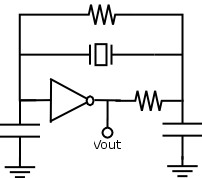I am building a MCP2200 breakout circuit getting reference from the guide by Microchip itself MCP2200 Breakout Board and I tried with two MCP2200 ICs but it doesn't get detected by the PC. I salvaged a 12MHz Oscillator from an old Arduino Mega board using CH340G IC which didn't work for some reason.
I checked out this post MCP2200 doesn't work everytime and tried to increase the capacitor values across the oscillator pins but still no luck. So my assumption is the oscillator is not working.
Could it really be? As a crystal oscillator is a simple circuit as follows;
I tried measuring the voltage values across osc pins and they were 0.17 V. Could overheating with hot air damage the crystal?



Best Answer
First what you show is just a quartz crystal and not an oscillator - an oscillator is a complete circuit which you supply with some voltage and which will give you a clock output on another pin.
A quartz crystal is also not a simple circuit, what you have shown is the equivalent circuit used to simulate and describe crystal properties.
It is a piezo-crystal, depending on the type it is either a ceramic or quartz crystal. Usually a ceramic one will be labeled ceramic resonator.
Both of them will be a mechanical beam or some other form and resonate at the specified frequency.
Piezo materials will loose their property when heated beyond the Curie temperature of the material, so overheating is one form to make crystals fail.
Piezo materials usually also are brittle so they are susceptible to mechanical shocks which can break them.
If you have in fact just a crystal and not a complete oscillator, then the layout of the circuit plays a critical role as well. Parasitic capacitance can influence the circuit in such a way that it won't start oscillating. Selecting the correct load capacitance can be a bit of a hassle.
Measuring with a multimeter is completely pointless as you cannot see anything of the oscillation. You also can't judge the amplitude as typical multimeters measure maybe up to 100 kHz or something and not 12 MHz. You need to use an oscilloscope.
Measuring without low capacitance probes (< 1 pF) will change the circuit so dramatically that you measure something completely different when you put your probe there. With normal probes you can just measure the output of the buffer - but that is commonly internal of the chip.
Do you even have load capacitors? On ceramic resonators they are often built in (3 pin devices) on quartz crystals they are often not (2 pin devices) if you don't have them, it won't work.